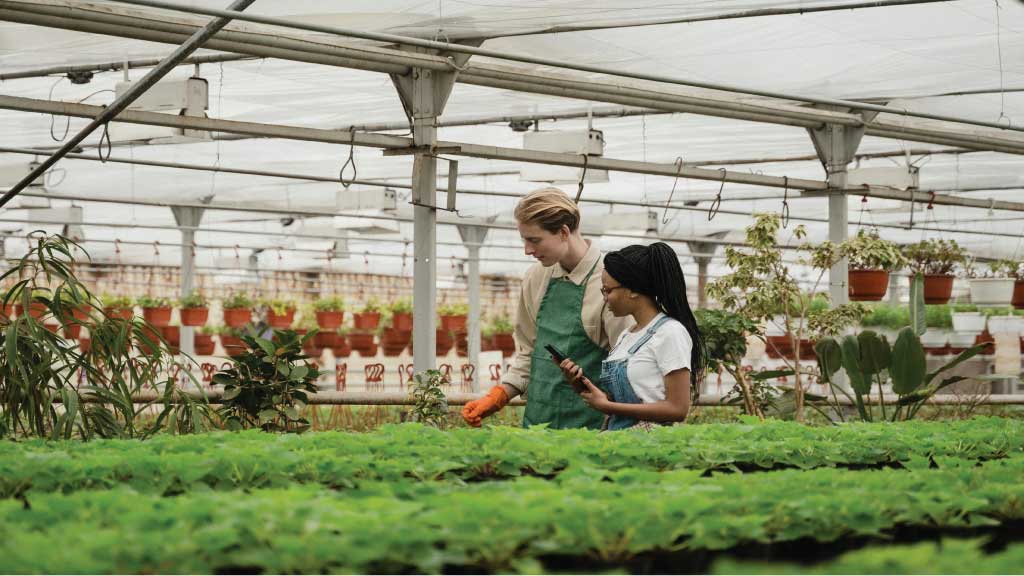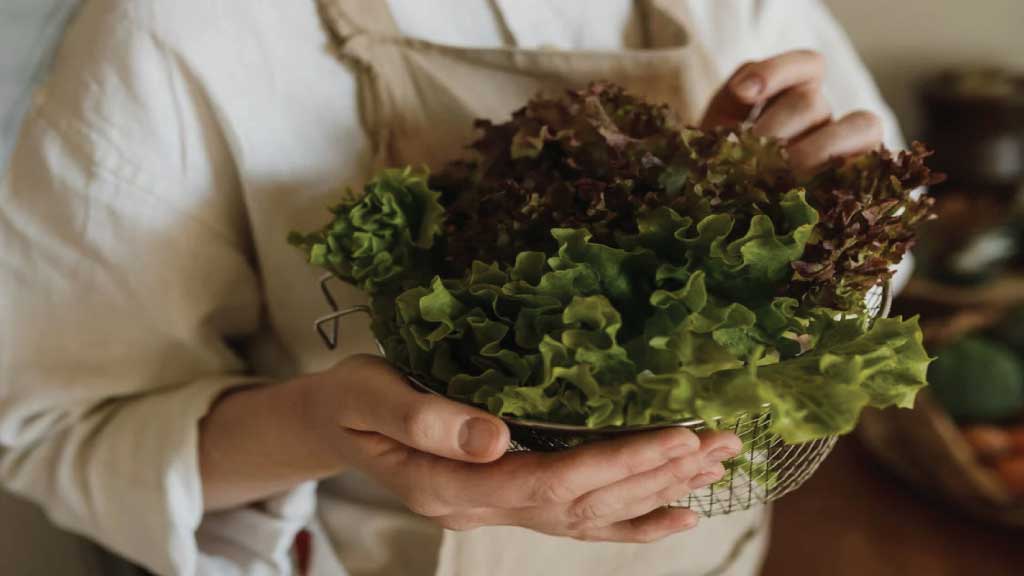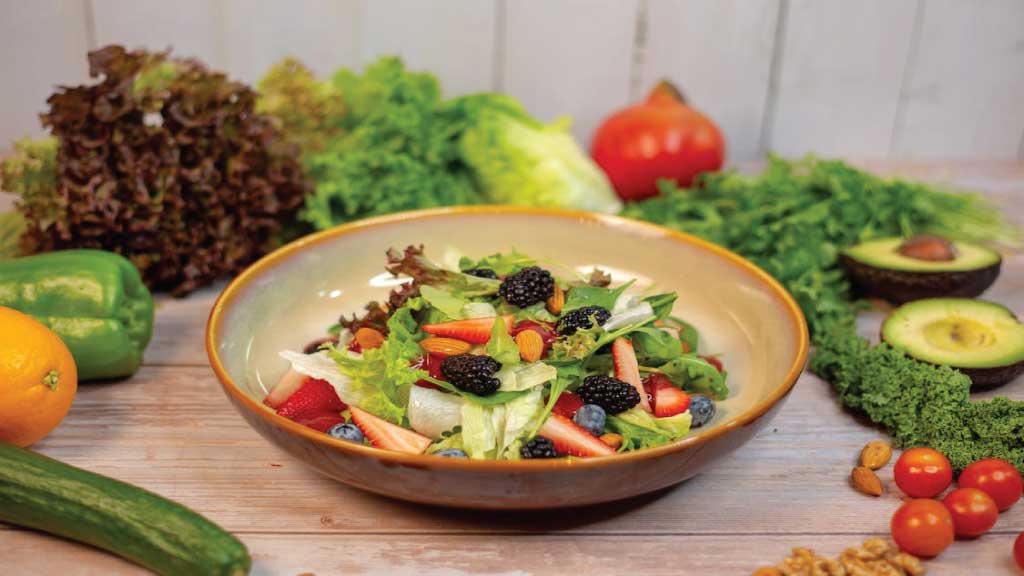Iceberg Lettuce
Iceberg lettuce, distinguished by its compact, round head and crisp texture, remains one of the most recognizable varieties. Its pale green leaves form tightly packed layers, giving it a firm and crunchy bite. This lettuce type is a popular choice for salads and sandwiches due to its refreshing taste and ability to hold up well in cold dishes. While it may lack the distinct flavor profile of other lettuce varieties, its mild taste and sturdy structure make it a versatile option for various culinary applications.
Romaine Lettuce
Romaine lettuce, also known as cos lettuce, boasts elongated leaves with thick ribs and a robust flavor profile. Its crunchy texture and slightly bitter taste add depth to salads and wraps, making it a favorite among salad enthusiasts. Romaine lettuce’s sturdy leaves make it ideal for hearty salads, as they can withstand robust dressings and toppings without wilting. Additionally, its vibrant green color and bold crunch elevate the visual appeal of any dish it graces.
Butterhead Lettuce
Butterhead lettuce stands out for its tender, buttery leaves that offer a delicate texture and mild flavor. Unlike other lettuce types, butterhead lettuce forms loose heads with soft, floppy leaves, making it a favorite for salads and sandwiches. Its subtle sweetness and velvety texture provide a delightful contrast to crunchy vegetables and tangy dressings. While not as crisp as iceberg or romaine lettuce, butterhead lettuce’s melt-in-your-mouth quality makes it a luxurious addition to any dish.
Leaf Lettuce
Leaf lettuce encompasses a diverse range of varieties, including green leaf, red leaf, and oak leaf lettuce. These lettuce types feature loose heads or clusters of leaves in various colors and shapes, ranging from frilly and curly to smooth and elongated. Known for their tender texture and nuanced flavors, leaf lettuce varieties offer a spectrum of tastes from sweet to peppery, making them versatile options for salads. Their delicate leaves wilt easily, so they are best enjoyed fresh and lightly dressed to preserve their crispness and flavor.
Salads
Lettuce is synonymous with salads, serving as the quintessential base for a wide variety of refreshing and vibrant dishes. Its crisp texture and mild flavor provide the perfect canvas for an array of toppings, dressings, and accompaniments. From simple garden salads to elaborate gourmet creations, lettuce adds a refreshing crunch and visual appeal to every bite. Whether mixed with other leafy greens or featured as the star ingredient, lettuce brings a burst of freshness and nutrition to salads, making them a satisfying and healthy meal option for any occasion.
Sandwiches and Wraps
In the realm of sandwiches and wraps, lettuce plays a crucial role in adding both texture and flavor. Whether it’s a classic BLT (bacon, lettuce, and tomato) or a hearty veggie wrap, lettuce provides a satisfying crunch and vibrant color to every bite. Its crisp leaves create a contrast of textures against soft bread or tortillas, while its mild flavor complements a wide range of fillings and condiments. Whether served cold or grilled for a warm sandwich, lettuce adds a refreshing and nutritious element to sandwiches and wraps, making them a popular choice for lunch or a quick meal on the go.
Juicing and Smoothies
While lettuce may not be the first ingredient that comes to mind when making juices or smoothies, its mild flavor and high water content make it an excellent addition to green drinks. Incorporating lettuce into juices and smoothies adds a boost of vitamins, minerals, and hydration without overpowering the flavor. Its neutral taste blends seamlessly with other fruits and vegetables, allowing the flavors of the other ingredients to shine through while still benefiting from the nutritional goodness of lettuce. Whether mixed with fruits like apples and berries or blended with leafy greens like spinach and kale, lettuce adds a refreshing and nutritious element to any juicing or smoothie recipe.
Cooking Applications
Although lettuce is most commonly enjoyed raw in salads, it can also be cooked to enhance its flavor and texture in warm dishes. Grilling or sautéing lettuce briefly can impart a smoky flavor and caramelized edges, transforming it into a delicious side dish or topping for grilled meats and seafood. Additionally, cooked lettuce can be incorporated into soups, stir-fries, and pasta dishes for added nutrition and flavor. While less conventional than its raw counterpart, cooked lettuce offers a unique and unexpected twist to familiar dishes, proving that this versatile leafy green can be enjoyed in a variety of culinary applications.
Lettuce in Popular Culture
References in Literature and Media
Lettuce, with its crisp leaves and refreshing taste, has been featured in various cultural works, including literature, film, and art. Often depicted as a symbol of freshness, vitality, and simplicity, lettuce appears in scenes depicting bountiful harvests, lush gardens, and vibrant marketplaces. In literature, authors use lettuce as a descriptive element to evoke imagery of verdant landscapes or to characterize scenes of abundance and plenty. Similarly, in media such as television and film, lettuce often makes cameo appearances in kitchen scenes or as a garnish on plates, adding visual interest and reinforcing themes of health and wellness.
Symbolism and Significance
Beyond its culinary uses, lettuce holds symbolic significance in different cultures around the world. In ancient civilizations, lettuce was associated with various symbolic meanings, including prosperity, fertility, and renewal. In Greek mythology, lettuce was sacred to the goddess Demeter, who was revered as the goddess of agriculture and fertility. In Roman culture, lettuce was often used in religious ceremonies and festivals to symbolize abundance and prosperity.
Additionally, lettuce has been linked to rituals surrounding spring festivals and celebrations of renewal, where it symbolizes the rebirth of nature and the promise of a bountiful harvest. In modern times, lettuce continues to carry symbolic connotations, representing concepts such as freshness, purity, and simplicity. Its crisp texture and vibrant green color evoke feelings of vitality and well-being, making it a popular choice for health-conscious consumers. Whether enjoyed in salads, sandwiches, or smoothies, lettuce serves as a reminder of the importance of incorporating fresh, wholesome foods into our diets.
Furthermore, its association with renewal and growth reinforces the idea of embracing change and embracing new beginnings. Overall, lettuce’s symbolic significance reflects its enduring popularity and cultural significance as a versatile and nutritious vegetable.
Classic Caesar Salad
Indulge in the timeless elegance of a Classic Caesar Salad, where crisp romaine lettuce takes center stage. Begin by washing and drying the lettuce thoroughly to ensure maximum crispness. Tear the leaves into bite-sized pieces and place them in a large bowl. Next, drizzle the lettuce with creamy Caesar dressing, tossing gently to coat each leaf. Sprinkle freshly grated Parmesan cheese over the salad, adding a rich and savory depth of flavor. Finally, top the salad with homemade croutons for a satisfying crunch that complements the creamy dressing perfectly. Serve immediately as a side dish or add grilled chicken or shrimp for a hearty main course.
Grilled Lettuce with Balsamic Glaze
Elevate your grilling game with Grilled Lettuce drizzled with balsamic glaze, a simple yet sophisticated side dish that will impress your guests. Begin by halving heads of lettuce and brushing them lightly with olive oil to prevent sticking. Place the lettuce halves on a preheated grill and cook for a few minutes on each side until lightly charred and tender. The heat of the grill adds a smoky flavor to the lettuce while maintaining its crisp texture. Once grilled to perfection, transfer the lettuce to a serving platter and drizzle with balsamic glaze for a sweet and tangy finish. Garnish with freshly chopped herbs or a sprinkle of sea salt before serving alongside your favorite grilled meats or seafood.
Lettuce Wraps with Asian-Inspired Filling
Embark on a culinary journey with Lettuce Wraps filled with a savory mixture of minced chicken, vegetables, and Asian-inspired seasonings. Begin by sautéing diced chicken breast in a skillet until cooked through, then add diced vegetables such as bell peppers, onions, and water chestnuts for added crunch and flavor. Season the mixture with soy sauce, ginger, garlic, and a hint of chili paste for a kick of heat. Once the filling is cooked and seasoned to perfection, spoon it into large lettuce leaves, using them as a vessel to hold the flavorful filling. Wrap the lettuce leaves around the filling, securing them with toothpicks if necessary, and serve immediately for a light and satisfying meal that’s bursting with flavor.
These lettuce wraps are perfect for a quick weeknight dinner or a fun and interactive appetizer for gatherings with friends and family.
Fun Facts about Lettuce
Unusual Varieties
Lettuce enthusiasts will be delighted to discover the wide array of unique and visually striking lettuce varieties available for exploration. While most people are familiar with the common iceberg, romaine, and butterhead lettuces found in grocery stores, there are numerous lesser-known varieties waiting to be discovered. For example, red oak leaf lettuce boasts frilly, crimson-colored leaves that add a pop of color to salads and dishes. Similarly, speckled trout lettuce features striking speckled leaves resembling the skin of a trout, adding both visual interest and flavor to culinary creations.
Other unusual varieties include Lollo Rossa, with its curly red leaves, and Freckles, known for its speckled green and red foliage. With such a diverse range of options available, lettuce lovers can explore new flavors, textures, and colors to elevate their culinary experiences.
World Records Related to Lettuce
Lettuce has earned its place in the record books, with enthusiasts achieving remarkable feats that showcase the vegetable’s popularity and versatility. Among the most notable records are those related to the size and length of lettuce heads and leaves. For instance, in 2014, a group of gardeners in the United Kingdom set a record for the largest lettuce head, weighing in at a whopping 61 pounds. In addition to size, lettuce aficionados have also set records for the longest lettuce leaf, with one specimen measuring over six feet in length. These quirky achievements not only highlight the impressive growth potential of lettuce but also demonstrate the creativity and dedication of growers worldwide.
Beyond size-related records, lettuce has also been featured in unique competitions, such as lettuce leaf sculpting contests and lettuce-themed festivals, further showcasing its versatility and cultural significance. Whether breaking records or simply enjoying its crisp texture and refreshing flavor, lettuce continues to captivate and inspire enthusiasts around the globe.
Editor’s Choice:
20 Lunch Ideas | Boost Your Fitness
10 healthy protein lunch ideas
10 Amazing Carrot Juice Benefits
Conclusion
Lettuce, celebrated for its crisp texture, delicate flavor, and nutritional richness, has firmly established itself as a dietary essential across the globe. Its refreshing presence elevates dishes, whether served raw in salads or incorporated into diverse culinary creations. By delving into the spectrum of lettuce varieties, exploring optimal growing techniques, unraveling its versatility in cooking, and acknowledging its cultural significance, we gain a deeper appreciation for this humble yet versatile leafy green. Lettuce not only tantalizes the taste buds but also enriches our meals with essential vitamins and minerals, underscoring its importance in promoting overall health and well-being.
FAQs:
How many types of lettuce are there?
There are several types of lettuce, including iceberg, romaine, butterhead, and leaf lettuce. Each type has its own unique flavor, texture, and appearance, offering a wide range of options for culinary experimentation.
Is lettuce a good source of vitamins and minerals?
Yes, lettuce is a nutrient-rich vegetable that contains essential vitamins and minerals such as vitamin A, vitamin K, folate, and potassium. Incorporating lettuce into your diet can help support overall health and well-being.
Can lettuce be grown in containers?
Yes, lettuce is well-suited for container gardening and can thrive in pots, window boxes, or raised beds. Choose compact varieties and ensure the containers have adequate drainage to prevent waterlogged soil.
How do I store lettuce to keep it fresh longer?
To prolong the freshness of lettuce, wash and dry the leaves thoroughly, then store them in a clean, breathable container lined with paper towels. Keep the container in the refrigerator crisper drawer and replace the paper towels as needed to absorb excess moisture.
Are there any creative ways to use lettuce besides salads?
Yes, lettuce can be used in a variety of creative ways beyond salads. Try using large lettuce leaves as wraps for filling with proteins and vegetables, adding shredded lettuce to sandwiches and tacos for extra crunch, or grilling lettuce halves for a unique smoky flavor in warm dishes. Let your imagination guide you in exploring the versatility of lettuce in your culinary creations.





